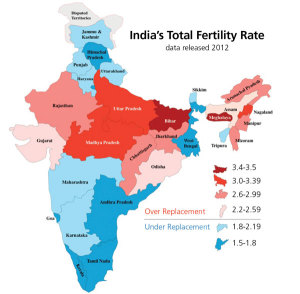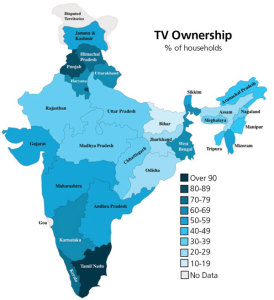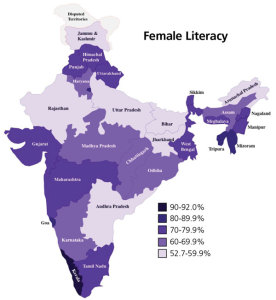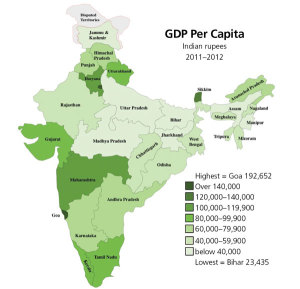How to defuse the population bomb: Provide people with a steady diet of soap operas and reality TV shows that depict modern, urban lifestyles. New research makes a compelling case that when TV ownership rises, fertility falls.
Earlier this year Stanford human geographer Martin Lewis asked his students a simple question: How did they think U.S. family sizes compared with those in India? Between Indian and American women, who had the most children? It was, they replied, a no-brainer. Of course Indian women had more—they estimated twice as many. Lewis tried the question out on his academic colleagues. They thought much the same.
But it’s not true. Indian women have more kids, it is true, but only marginally so: an average of 2.5 compared to 2.1. Within a generation, Indian women have halved the number of children they bear, and the numbers keep falling.
It’s not that the population problem has gone away in India—yet. India has a lot of young women of childbearing age. Even if they have only two or three children each, that will still continue to push up the population, already over a billion, for a while yet. India will probably overtake China to become the world’s most populous nation before 2030.
But India is defusing its population bomb. A fertility rate of 2.5 is only a smidgen above the long-term replacement level, which—allowing for girls who don’t reach adulthood and some alarming rates of aborting female fetuses—is around 2.3. The end is in sight.
With most of the country still extremely poor, this is a triumph against all expectations. And it offers some intriguing clues to a question that has dogged demographers ever since Paul Ehrlich published his blockbuster book The Population Bomb: What can persuade poor people in developing countries to have fewer babies?
Taking time off from bemusing his students, Lewis decided to investigate. Being a geographer, he tackled the question with maps. He noted that, within the overall rapid decline in Indian fertility, there continued to be great regional variations. So he mapped fertility in each Indian state and examined those patterns against the patterns for some of the demographers’ favored drivers of lowered fertility. When he compared his maps, he found that variations in female education fit pretty well. So did economic wealth and the Human Development Index, which measures education, health, and income. The extent of urbanization looked like a pretty good match, too. But he also found that TV ownership tallied well with fertility across India. Not perfectly, he concluded, but as well as or better than the more standard indicators. A TV in the living room, in other words, might have the power to transform behavior in the bedroom.
Surprising? Maybe not. Lewis was following the lead of Robert Jensen and Emily Oster, development economists from the University of California, Los Angeles, and the University of Chicago, respectively. Four years ago, they reported compelling direct evidence from Indian villages that TV empowers women. They carried out detailed interviews in rural India as commercial cable and satellite TV were replacing the mostly dull and uninspired government programming. (1)
Maps made by Martin W. Lewis for GeoCurrents
The pair noted that the new diet of game shows, soap operas, and reality shows instantly became the villagers’ main source of information about the outside world—especially about India’s emerging urban ways of life. At the top of the ratings was Kyunki Saas Bhi Kabhi Bahu Thi (meaning “Because a mother-in-law was once also a daughter-in-law”). Based on life in the megacity of Mumbai, it was Asia’s most watched TV show between 2000 and 2008 and was an eye-opener for millions of rural Indian women. They saw their urban sisters working outside the home, running businesses, controlling money, and—crucially—achieving these things by having fewer children. Here was TV showing women a world of possibilities beyond bearing and raising children—a world in which small families are the key to a better life.
Soap operas give viewers time to develop strong emotional bonds with the characters, many of whom live as they do and experience the life traumas that they do. The impact of the new TV programming in rural India has been profound—and very positive, say Jensen and Oster. Their interviews revealed that when the new TV services arrived, women’s autonomy increased while fertility and the acceptability of domestic violence toward women significantly decreased. Most of the changes occurred within a few months of the arrival of TV reception, when (as they put it) “interactions with the television are more intense.” In fact, the researchers found that TV’s influence on gender attitudes, social advancement, and fertility rates was equivalent to the impact of an extra five years of female education. This was the social revolution that delivered the geographical variation in Lewis’s maps.
There is a history to using soap operas to cut fertility. It goes back to Mexico in the late 1970s, a time when the average Mexican woman had five or six babies and Mexico City was becoming the world’s largest megacity. Miguel Sabido, then vice president of Televisa, the national TV network, developed a soap-opera format in which viewers were encouraged to relate to a character on the cusp of doing right or wrong—a “transitional character” whose ethical and practical dilemmas drove the plotlines.
His prime soap, or telenovela, Acompáñame (“Accompany Me”) focused on the travails of a poor woman in a large family living in a run-down shack in a crime-ridden neighborhood. She wanted to break out and, after many travails and setbacks, did so by choosing contraception and limiting her family size. It was a morality tale, and nobody could mistake the message. The lessons were reinforced with an epilogue at the end of each episode, giving advice about family planning services.
Some accused Sabido of crude social engineering. But according to research by the country’s National Family Planning Program, half a million women enrolled at family planning clinics while the soap was on, and contraceptive sales rose 23 percent in a year. A rash of similar soap operas with names such asVamos Juntos (“We Go Together”) and Nosotros las Mujeres (“We the Women”) ran in Mexico throughout the 1980s. They were credited, at least anecdotally, with helping slash Mexican fertility rates. Thomas Donnelly, USAID’s local man at the time, concluded that they “have made the single most powerful contribution to the Mexican population success story.”
The “Sabido Method” caught on. American population campaigner William Ryerson later launched the Population Media Center in Shelburne, Vermont, to promote it worldwide. Among many copycat shows were Jamaica’s Naseberry Street, which ran from 1985 through 1989, a period during which the fertility rate on the Caribbean island fell from 3.3 to 2.9; and Kenya’s long-running Tushauriane (“Let’s Talk About It”), launched in 1987. It topped the ratings and coincided with a cut in Kenyan fertility rates from 6.3 to 4.4 children.
But the precise contribution of such programs to falling fertility rates was always elusive. And more sophisticated TV viewers reacted against the crude propaganda of some Sabido soaps, with their clunky storylines and dialogue right out of government leaflets. The next wave of soap operas became more subtle: soft soap, if you will. Their narratives offered a realism that simply associated smaller families and use of family planning services with aspirational lifestyles, perfect family lives, and female emancipation. Thus it is not overt propaganda messages that really transform, so much as the window TV offers on a world previously unknown to most women. Seeing is believing.
A pioneering study into these more subliminal soap messages was published in 2008 by Eliana La Ferrara of Bocconi University in Milan and colleagues at the Inter-American Development Bank. She looked at more than a hundred Brazilian telenovelas broadcast from the 1970s to the 1990s, finding that 72 percent of the main female characters younger than 50 years old had no children and a further 21 percent had only one child. At the start of this period, such a picture of Brazilian life was far from reality: the average woman had five children. But by the end, life had imitated art: Brazilian fertility today is 1.8 children per woman. (2)
The core of La Ferrara’s study looked at the impact of the slow geographical spread of programming by Rede Globo, a TV network that for a long time had a near monopoly on Brazilian telenovelas. She found that, as the soaps reached each region and as the majority of the population tuned in, there was a discernible, additional fall in fertility. She was able to demonstrate that the soaps were responsible for an average six percent fall in fertility overall and an 11 percent drop among women over 35. What’s more, fertility was falling across Brazil at a time when opposition from the Catholic Church kept government out of the business of family planning.
Of course, the messages about small families that are conveyed in soap operas and other popular media are in keeping with existing trends. They reflect and encourage emerging norms and aspirations about family size as much as they actually create them. But the evidence from India and Brazil—these two large countries that have been most successful in reducing fertility—is that at a certain stage in the process of change, the impact of soaps can be swift and dramatic.
We do not often hear about this reproductive revolution, says Lewis—even though many environmentalists argue that future population trends are absolutely critical to the future sustainability of humans on the planet. “It almost seems as though we have collectively decided to ignore this momentous transformation of human behavior.”
Perhaps the disconnect comes from how we think about the problem. Understanding the current human population equation requires us to hold two opposing ideas in our heads at the same time. First, birth rates globally are falling almost everywhere. As John R. Wilmoth, the new head of the United Nations Department of Economic and Social Affairs Population Division, noted earlier this year: “Fertility levels have fallen substantially in most regions, far beyond what most observers expected 50 years ago.” Half the world now lives in countries with fertility at or below the long-term replacement level of 2.3. That includes some devoutly Muslim countries, such as Iran, as well as many primarily rural countries where girls get a meager education and are often forced into marriage at a very young age. The average woman of the world today has 2.5 children, half what her mother and grandmother had.
The second fact is that despite falling fertility, there is a considerable increase in overall human numbers still to come. The U.N.’s statisticians this year raised their estimate of the likely increase in the world’s population in this century. They predict that, rather than growing from today’s 7.2 billion to 10.1 billion, the population will increase to almost 11 billion people by century’s end. One reason for the apparent paradox of fast-falling fertility and continuing high population projections is that today’s mothers were born at a time when women still had four or five children—most of whom, for the first time in history, grew to adulthood. As in India, this baby-boom generation is so numerous that, even with small families, they will inflate the numbers substantially before ceasing to be fertile. Also, to a lesser extent, rising life expectancy will increase the population.

The number of people added to the planet each year is in decline (blue) as fertility rates dip below replacement level in many countries. Still, the latest projections show that population will continue to grow throughout the 21st century, although more slowly than in recent decades (gray). World population doubled in just 40 years to reach 6 billion in 1999. It is now expected to reach 9 billion by 2044, an increase of just 50 percent over 45 years. Source: U.S. Census Bureau, International Data Base, June 2011 Update
But the rate of worldwide population increase is declining, from 2.1 percent in the 1960s to today’s 1.2 percent. And demographers recently noted that we have reached what they call “peak child.” The number of children younger than 15 has stopped rising and is likely to start falling in the future.
Some countries, notably in southern and eastern Europe and in East Asia, have seen their fertility rates fall well below replacement level for a generation now. From Italy and Greece to Russia, Japan, and South Korea, this figure is at or below 1.5. Many argue that modern women in such countries are, in effect, on childbirth strike because their male partners, employers, and governments make it hard for them to combine parenthood with a career.
Will fertility rates in these countries recover to replacement levels? The U.N. currently believes they will, though no country has yet done so fully. Women may not do what the demographers think they will.
At the other end of the spectrum are questions about the fate of sub-Saharan Africa; here, despite some decline, fertility rates are often still above three children per woman. The rates reach seven children per woman in Niger and Mali in West Africa. Poor peasant farmers still often see children as a good investment in labor on the farm as well as an insurance policy for their old age.
If things go badly, Africa could end the century with as many as 3 billion people, compared to 1 billion today. The U.N. is currently of that view. It regards numerous African nations as being stuck in a poverty trap that is also a fertility trap. Recently, it upped its estimates of both Africa’s current fertility rates and its likely future rates. It reckons, for instance, that Africa’s most populous nation, Nigeria, will surge from around 175 million today to more than 800 million before the century is out.
But others think that Africa in the twenty-first century could follow the Asian example from the late twentieth century, with fertility falling dramatically to replacement levels or below.

The number of people age 65 and over will more than double as a proportion of the global population between 2000 and 2050. Meanwhile, young people account for a smaller and smaller proportion of the population. Source: U.S. Census Bureau, International Data Base, June 2011 Update
Who’s right? Optimists point out that poverty no longer dooms countries to high fertility, as shown by examples such as Burma and Bangladesh. But pessimists say it is unlikely that hard-pressed African governments will be delivering either wealth or Asian-style education systems to their fast-growing citizenry any time soon.
However, it may be a mistake to think that governments are key to reducing fertility. Evidence from both Asia and Latin America indicates that wider social forces are at work: women are making their own choices. Female emancipation is key.
This could happen in Africa, too. Time and again, surveys show that most African women also want smaller families. Even in the poorest countries, advances in health care and campaigns against major killer diseases mean that most kids grow to adulthood. Women do not need to produce large families in order to deliver the next generation. But they still must take charge of their lives sufficiently to achieve small families; this requires cultural change. And as we have seen, in much of the poor world these cultural drivers come not from books, school teachers, tribal chiefs, or even the words of priests and mullahs. As in the villages of India and Brazil, the most dynamic force in changing social mores in villages and slum communities is a box in the corner of the living room: the TV.
Television’s spread throughout the world is extraordinary. There are today something like 1.4 billion TV sets worldwide, or roughly one for every five people. In Asia and Latin America, even the poorest are glued to the box. In India, states where the average daily income is below two dollars per person still have TV sets in more than half of households, say Jensen and Oster.
In Africa, however, the spread has been slower. Across the continent, a billion people have only around 50 million TV sets. Government television broadcasting is mostly amateurish and unattractive. Satellite dishes to access other stations remain rare outside southern Africa. Most people still listen primarily to the radio.
But growing evidence suggests that TV could be the catalyst for change. In Kenya Makutano Junction, a TV soap funded by the British government’s Department for International Development (DFID) together with family planning agency Marie Stopes International, is now in its twelfth series. The Sunday evening prime-time staple has 7 million viewers in Kenya and many more in neighboring Tanzania and Uganda. It addresses a range of social issues, with family planning at the forefront.
In a recent series, female hero Anna loses her twins in childbirth after failing to attend a clinic. She leaves the hospital with her abject partner Josiah, who declares, “You are right. I should have come with you for checks at the clinic. Now we’ll go to family planning like you wanted.”
Since Makutano Junction went on air in 2001, Kenya’s fertility rate has fallen from 5.0 to 3.8. DFID makes no great claim that Makutano Junction caused this drop. “The extent to which MJ is able to contribute to actual changes in behaviour is difficult to establish,” it says. But audience research shows viewers appreciate and act on “very specific and practical information” that MJ provides—for instance, how to find Marie Stopes clinics.
Similarly, Ethiopia’s Amharic-language radio show Yeken Kignit (“Looking Over One’s Daily Life”), broadcast from 2002 to 2004, coincided with an estimated fall in fertility rates in Amharic-speaking areas from 5.4 to 4.3. That also coincided with a big increase in demand for contraceptives in those areas, says the Population Media Center’s Ryerson.
We should not think the power of soaps is a purely developing world phenomenon. Many argue that soaps have played a role in triggering changes in attitudes toward homosexuality and gay marriage in Europe and North America, for instance. And even Sabido-style programs are being tried in rich nations. Witness the arrival of online soaps with overt messages, such as East Los High at hulu.com. Launched in June 2013, the soap—funded by the Population Media Center with help from the California Family Health Council—targets Latino teens with tales of a girl from a single-parent household who struggles against temptation.
Looking back, it’s ironic that many of the same activists warning of the population bomb back in the 1960s were also telling people to “kill your TV.” They saw TV as a socially damaging technology, bringing in its wake violence, destructive consumer desires, and social dislocation. But TV can also be a force for good, giving isolated and underprivileged people—especially women—a window on different worlds and a sense that they can change their lives. It empowers and increases aspirations—and even delivers lower fertility rates. Could the humble soap save the world? Stay tuned.
Fred Pearce is an author and journalist based in London. He has reported on environment, popular science, and development issues from 64 countries over the past 20 years. Currently the environment consultant of New Scientist magazine and a regular contributor to British newspapers, he is the author of more than 15 books, including The Climate Files, Peoplequake, Confessions of an Eco-Sinner, When the Rivers Run Dry, and Deep Jungle.
This post was originally published by the University of Washington in the Fall 2013 issue of Conservation Magazine, view the original here.
Literature Cited
Jensen, R. and E. Oster. 2009. The power of TV: Cable television and women’s status in India. The Quarterly Journal of Economics doi:10.1162/qjec.2009.124.3.1057.
La Ferrara, E., A. Chong and S. Duryea. 2012. Soap operas and fertility: Evidence from Brazil. American Economic Journal: Applied Economics doi:10.1257/app.4.4.1.
MAHB-UTS Blogs are a joint venture between the University of Technology Sydney and the Millennium Alliance for Humanity and the Biosphere. Questions should be directed to joan@mahbonline.org
The views and opinions expressed through the MAHB Website are those of the contributing authors and do not necessarily reflect an official position of the MAHB. The MAHB aims to share a range of perspectives and welcomes the discussions that they prompt.




